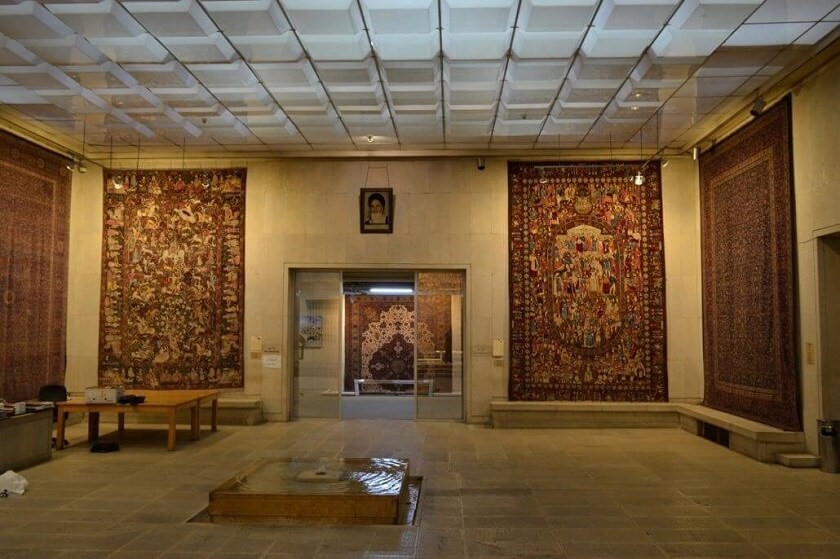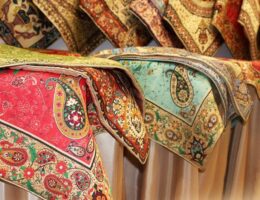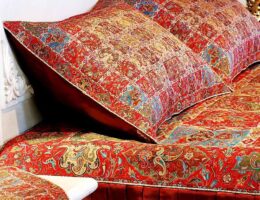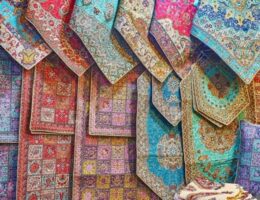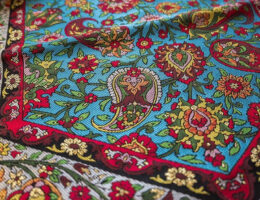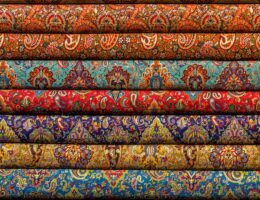IRAN ART EXHIBITION: PERSIAN CARPETS ARE CONSIDERED AS IRANIAN CULTURE
Have you ever tried mentioning Iran’s name amidst a conversation on handicrafts and souvenirs of different countries around the world? What have you heard about Persian carpets? Have you ever asked someone what comes to their mind when you mention the word “Persian”? What was their answer? Persian cats maybe, or Persian carpets?
The name of Iran, among many other things, is tied to rug and carpet. These products have followed the country’s name and heritage for more than 2,500 years. Myth and history prove the presence of carpets and carpet weaving in Iran for a very long time. This everlasting presence has had its effects on the art of weaving carpets, different materials, diverse designs, and national interest and growth in producing something that is rightfully considered as art is also the footstone of the Persian lifestyle.
PERSIAN RUG BELT
There is a hypothetical belt on the world map that shows countries that are known for producing hand-made carpets for so long, having the best designs and qualities. Countries such as Turkey, India, Nepal, Pakistan, Afghanistan, and China are among those countries. Iran, located geographically at the center of this belt is also considered to be the best producer of hand-made carpets in the world, be it the design or the high quality of the final product. You must have noticed the presence of a Persian rug on the stages in some concerts or music recording studios all over the globe. Have you ever wondered why? It cannot be just for the beauty of it! Of course not, elegance and design apart, it is because of the tough texture of the Persian carpet that eventually will help the musicians with how their music sounds.
WHERE DOES PERSIAN CARPETS COME FROM?
There is a legend about the great Iranian king, Cyrus the Great. It says that it was during the invasion of Babylon in 539 BC that Cyrus became familiar with carpets and introduced them to Persians, and that is where it all has started.
Whether that story is true or not, we cannot be sure, as there is no hard evidence proving that. However, there are records in ancient Greek literature, for example, in Xenophon’s Anabasis, that introduces Persian carpets as precious products worthy of being used as diplomatic gifts.
Nevertheless, the most critical evidence of Persian carpet’s history would be the Pazyryk carpet kept in the Hermitage Museum. It was found in an ancient grave in Siberia, which radiocarbon testing has proven to be of almost 2,500 years old. Noticeable in the Pazyryk carpet is the robust texture and elaborate design that shows years and years of experience and knowledge of weaving rugs.
DEVELOPMENT IN HISTORY OF PERSIAN CARPETS
Although the footsteps of Persian carpet can be traced alongside Iran’s history, there are not so many carpets left from different eras. Be it for the texture and nature of the carpets that can be damaged throughout centuries if not taken care of properly, or the historical events and different wars and invasions that have happened numerous times. The Persian carpet, especially those kept in courts that had gold and silver strings and different jewels, were taken as treasures.
Nevertheless, a tradition started many years ago in those days Persia and became a national art, developed in many aspects, and grew through centuries to be what it is now today.
IRAN ART EXHIBITION: Persian carpet weaving met its highest point of development during the sixteenth century. While the Safavid dynasty ruled over Iran, Persian art started to overgrow. Architecture, painting, miniature, and also carpet weaving developed, and new design ideas came into being. It was during this time that the design of the Persian carpet became so much closer to what we know of and identify with today. There are also some carpets left from that era which are being kept in museums such as Victoria and Albert in London, that hosts the magnificent Ardabil carpet which dates back to 1539-40, as the inwoven message of the artist/worker suggests:
“I have no refuge in the world other than thy threshold.
There is no protection for my head other than this door.
The work of the slave of the threshold Maqsud of Kashan. In the year 949,”.
Or the Hunting Carpet’s inwoven message which suggests the time of its production to be almost at the same time as the Ardabil carpet:
“By the diligence of Ghyath ud-Din Jami was completed this renowned work that appeals to us by its beauty. In the year 949.”
The “Hunting Carpet” is kept at the Austrian Museum of Applied Arts in Vienna.
HOW THE PERSIAN CARPET SPREAD THROUGH NATIONS
Persian carpet has been a diplomatic gift for ages. This can be one of the reasons it has traveled to so many countries and became known internationally. Also, throughout the long history of Iran, many changes have been made in Iran’s borderlines, and carpets have always been one of the products that were widely traded. So, the art and respect for carpet weaving have traveled to countries such as Turkey, India, Afghanistan, Pakistan, and Egypt. Some of these countries, as you may have noticed, are nowadays a part of the rug belt. The art of Persian carpet has found its way there and grew a different branch, combined with the host country’s traditions and artistic visions.
DIVERSITY OF PERSIAN CARPETS
The Persian carpet is easily recognizable due to its texture and design. Centuries of experience have enabled Iranians to produce something artistic and of the highest quality. Mostly Persian rugs are pile or wool woven, but there are silk woven carpets as well. There are also carpet weavers that use a combination of such materials.
The high quality of Persian carpets has many roots; one crucial source is the high number of knots in one centimeter that gives the Persian carpet a firm texture. This is also one of the ways to identify the quality of a carpet, knowing the number of knots. It is easily achieved if you turn a carpet and see its back, the knots will be visible, and also, if you can see the design almost as clearly as the front of the carpet, you have got a high-quality hand-made carpet for yourself.
DIFFERENT CITIES, DIFFERENT DESIGNS
Among many cities, villages, and tribes of carpet weavers in Iran, some are unique in style, design, and texture, and it had made them worldly famous.
Moving from Turkmen carpets in Northeast Iran with their symmetric designs with wool that usually use the colors of deep red and blue, to the northwest of Iran, cities like Tabriz and Ardabil with silk being added to the texture, and the more elaborate designs, such as garden and figure designs.
Moving downward on Iran’s map, right at the center, we have Isfahan, Qom, Kashan, and Naeen, whose carpet designs are unique. The medallion and corner design are prevalent in this region. Also, what is known as the monument design, such as the imitation of mosque designs in carpets, is common. Moving on, we have the city of Kerman with its high-quality carpets and unique designs. Dominant designs of Kerman carpets would include garden and vase designs. The Kerman carpets have been known to be of very high qualities, to the extent that there is a saying in the Persian language used to describe someone who looks suitable for their age; “You look so well, just like a Kerman carpet!”
IRAN ART EXHIBITION: Throughout time, there have been several tribes in Iran, moving from different parts of Iran’s plains and mountains in different seasons, for whom carpet weaving has always been an essential part of their life. Among them are the Qashqais with their unique both symmetric and animal designs in carpet, which are highly valued and a popular trend nowadays in interior design. These wool woven carpets of Qashqais with their different textures have found their ways into the modern designs of houses.

PERSIAN CARPETS AMONG PEOPLE
Carpets are an essential part of the Iranian lifestyle. Almost every house in Iran has at least one Persian carpet, if not several. Carpets are widely used and respected among Iranians. When you visit an Iranian home, you will see that they take their shoes off when they enter the house and especially when they are going to walk on the carpets to keep them clean. It is one of the integral elements of the Iranian lifestyle; a place feels like home when there is a Persian carpet in it, and this feeling would be a bit off if there is not one.
The diversity of Persian carpet designs and the time adaptation of its weavers to be aligned with the newest trends has enabled Iranians with different tastes to have a Persian carpet of their own desire at their homes. The range is so vast that it will surely satisfy the diverse tastes of different people from different parts of the world.
BAZAARS AND THE TEHRAN CARPET MUSEUM
Just like any other ancient country, Iran’s bazaars have been known to be historically and of course, economically the heart of the Iranian cities.
Tehran bazaars have unique corners dedicated to carpets. Persian carpet merchants of different cities have their own spaces in Tehran’s grand bazaar in the southern part of the town or even the small bazaar of Tajrish located in the north of Tehran. These corners in bazaars are the traditional places to buy carpets from and also to have an opportunity to see different types of carpets.
IRAN ART EXHIBITION: Tehran carpet museum founded in 1976, designed by the famous Iranian architect Abdulaziz Farmanfarmaian is of great architectural and historical importance as it hosts the diverse art of Persian carpet. From Tabriz silk carpets to Isfahan’s mosque designs to Kerman’s garden designs, from Turkmen and Qashqai symmetric patterns to Gilims, Jajims, and Gabbes; Tehran Carpet Museum hosts the variety of them all. Manifesting Iran’s rich heritage in carpet weaving, this museum is one of the best places to visit when you are in Tehran.
PERSIAN PARADISE
The word paradise comes from the Persian word Pardis. And Pardis means heavenly garden in Persian. The initial design of the Persian carpets has been taken from Pardis, which is now called the garden design. It is like Iranians have brought their beautiful gardens into their houses.
Carpets have represented Iran at different times and different levels throughout history, and they still do. But also, they can be considered as a representation of the Persian culture; enduring, artistic, valuable, and carrying a long history on their shoulders.
In Iran, every city, every village, and every tribe has its stories woven in warps and wefts of their carpets. Thus, one can talk endlessly about each knot and each design. A single Persian carpet has a lot of stories to tell, welcome to the land of Shahrzad!
